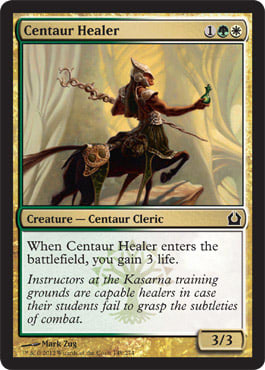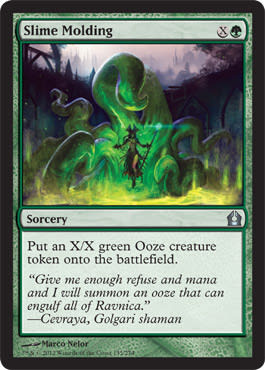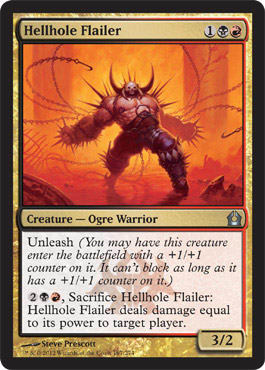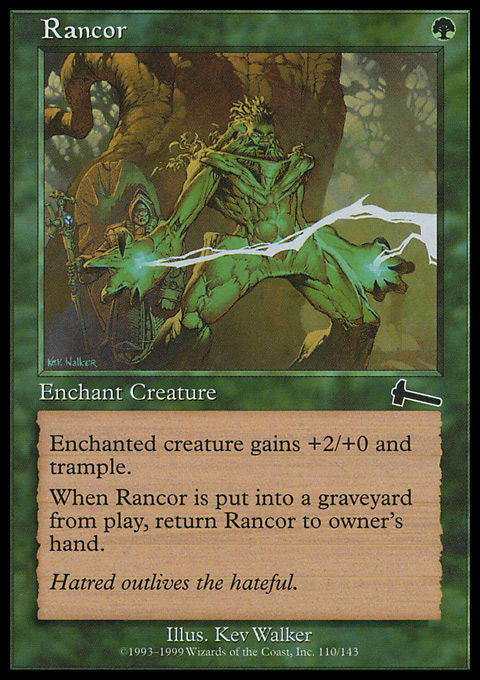As you might imagine, expectations for the intro packs of Return to Ravnica have been high. I mean, it's Ravnica, right? The original ten theme decks were decidedly mixed affairs, but for the most part, they did an admirable job giving you a feel of what each guild was up to, even if perhaps the gameplay wasn't always the best (I'm looking at you, Rakdos Bloodsport).
With a new set comes the chance to revisit the guilds and their new mechanics and a new slate of precons based around each one (though I'm really looking forward to seeing what the small, third set brings us, since each guild gets its due in either Return or Gatecrash). Of course, the modern-day intro pack has some considerations that weren't present during the heyday of the theme deck. In those wild, lawless days you could have all sorts of different constructions, from all creatures (Legions's Elvish Rage) to nearly creatureless (Stronghold's The Sparkler) to most anything in between. With the advent of the intro pPack, the product line was better positioned to welcome the new or returning player (as discussed in Tom LaPille's classic column Making Introductions). This means that things such as vanilla content and card diversity are pushed while consistency tends to take a bit of a backseat.
One of the fun things that leads us to do, however, is to use the decks as springboards to more consistent and advanced builds. I call this meddling, and in the past, we've taken a critical look at decks from Dark Ascension, Avacyn Restored, and Magic 2013. We're going to do something a little different this time around. Rather than meddle one of the decks, we're going to tinker with all five. Going forward, we'll be doing this on the respective theme weeks that coincide with those of the mothership. No more hoping that your favorite guild is the lucky one to go under the microscope; now, it's only a matter of time. Of course, Selesnya Week kicked off straightaway, and so that's the guild we'll be looking at today.
Selesnya Surge is a deck built around the populate mechanic. You have a suite of cards that make token creatures for you—mainly 1/1 Birds and 3/3 Centaurs—and a number of ways to start multiplying your token army. I'll be looking to take the core essence of this strategy, strip it down to its essentials, and rebuild a deck to be enhanced and advanced. As with previous meddlings, I'm limiting the available card pool to Return to Ravnica and Magic 2013 to make it easy to assemble at home for those wanting to give it a go. If your collection lets you draw upon other sets, you're certainly encouraged to do so! Finally, I'll be keeping it budget—the longstanding rule is no added rares or mythics. Again, use ’em if you got ’em, but we'll be doing without.
Now, let's move on to the stock deck and see what we have to work with.
"Intro Pack: Selesnya Surge"
- Creatures (17)
- 1 Arbor Elf
- 1 Axebane Stag
- 1 Brushstrider
- 1 Centaur Healer
- 1 Healer of the Pride
- 1 Phantom General
- 1 Risen Sanctuary
- 1 Vitu-Ghazi Guildmage
- 1 Wayfaring Temple
- 2 Centaur's Herald
- 3 Centaur Courser
- 3 Seller of Songbirds
- Spells (18)
- 1 Druid's Deliverance
- 1 Heroes' Reunion
- 1 Rootborn Defenses
- 2 Chorus of Might
- 2 Eyes in the Skies
- 2 Savage Surge
- 2 Trostani's Judgment
- 1 Coursers' Accord
- 2 Bountiful Harvest
- 2 Call of the Conclave
- 2 Selesnya Keyrune
- Lands (25)
- 11 Plains
- 12 Forest
- 1 Grove of the Guardian
- 1 Selesnya Guildgate
Cards We Cut
Ordinarily, I like to break this out into "creatures" and "spells" since most precon decks divide neatly along those lines. With Selesnya Surge and its collection of token-producing sorceries—and a land—the lines are a little blurrier. We'll be keeping some of these cards in particular, but overall, we'll be gutting the deck.
The first thing to go is the life-gain suite. That means the Centaur Healer, Healer of the Pride, Bountiful Harvest, and Heroes' Reunion are all off to the dustbin to make room for main-theme reinforcements. Life-gain has some niche applications such as outlasting mono-red burn decks or in dedicated life-total-matters constructions with Serra Avatar, but in general, it's not consistently useful. When you're ahead, you'll wish you'd drawn something else, and when you're behind, all it does is buy a little extra time without solving any of the problems that have put you behind in the first place. The Healer of the Pride in particular was a clever inclusion, designed to give you a little bump with every populate, but there's just better use of slots.
The second subtheme shown the door is the flying one. This route consists of Eyes in the Skies and Seller of Songbirds, neither of which is particularly effective at what we're after. After a few goes with the stock deck, you quickly realize that the only thing worse than blowing a populate trigger on a mere 1/1 Bird is having nothing to populate at all. For our purposes, we'd rather rebuild a deck that consistently lets you operate in the 3/3 Centaur range—even if it means giving up a little evasion.
Third, we're retuning the combat support suite. Selesnya Surge is packed with combat tricks. Cards like Chorus of Might, Druid's Deliverance, Rootborn Defenses, and Savage Surge all let you make the red zone a very unpredictable place for your opponent. This is amusing, but if we want to take the deck to a higher level of performance, we need to simply jettison these conditional combat tricks—populate and all—and instead make way for a real removal suite. In the stock list, that removal consists solely of a pair of Trostani's Judgments, and that's just no way to live.
Since we're swinging the axe with reckless abandon, let's next go after the creature lists. To begin with, vanilla and other low-impact creatures should get a one-way pass to the bread lines. The Axebane Stag and Risen Sanctuary are huge, but so are their sticker prices. The Brushstrider's vigilance is less sexy when paired with that 1 toughness. Centaur Coursers are on-curve, but we can do better. And the Phantom General is tempting, but . . . 4 mana.
Cards We Keep
So, where does this leave us? Not with much, though it's a fine foundation to begin from. The Arbor Elf is a no-brainer since a little ramp goes a long way in trying to be as aggressive a start as possible. In light of that, we'll not only keep the one we have, but add in three more to round out the play set while keeping the Selesnya Keyrunes as well. The Centaur's Herald isn't the best way to put a 3/3 token onto the battlefield, but with so much of the value of this deck relying on making that first, crucial token, she's not to be overlooked. We'll keep the two and throw in a third.
The updated version of Watchwolf checks in with Call of the Conclave, and this is another automatic play set—a 3/3 on turn two even now can be a significant advantage. Since we almost never cut rares so long as they earn their keep, the Wayfaring Temple is perfectly safe. Coursers' Accord gives us at least a pair of 3/3s for its 6 mana, but if we've even larger tokens in play, the value only goes up from there. It's expensive, but it’s a good turbo boost to turn the corner in the mid-to-late game. Finally, since we've cut some of our populate options when we culled the combat tricks, we'll throw in another three Vitu-Ghazi Guildmages to give us an even four.
For mana, we’ll round out a play set of the Selesnya Guildgates to give us some flexibility with our mana base, and of course, we’ll want to keep the Grove of the Guardian.
As it stands, we've now done away with the divergent lines of play the stock deck offered and put our focus on a steady stream of beats—mainly through tokens, but not exclusively. Rather than leaning on the populate mechanic to be what makes the deck effective, we want our end result to be a solidly effective deck on its own that is augmented by—rather than dependent upon—the Selesnyan parlor trick.
Cards We Add
To that end, we now get to fill in the gaps with other cards from Return to Ravnica and Magic 2013. The very first thing we'll want is a real, genuine removal package. Those Trostani's Judgments get to stick around, though at 6 mana, they're hard to be excited about. Still, the fact that they exile rather than destroy is highly relevant here, whether it be from Zombies decks or Golgari ones. The populate helps make it justify the cost, though as always, we'll want to mind the mana curve.
What's clear, though, is that we need a much more robust way to answer any threats our opponent puts on the board. Playing green and white, we have to react to what opponents use to congest the lanes and get in the way of our beaters hammering in. This makes a full play set of Arrest a superb addition, and for the extra mana, it manages to do what Pacifism can't: shut down a utility creature.
While we're at it, let's go ahead and grab a quartet of Oblivion Rings. From creatures to enchantments to planeswalkers, there's little that this card can't solve, and it gives a tremendous amount of versatility. In order to get the most out of our creatures, we'll also want a play set of Rancors. Back from a long absence, Rancor is the gift that keeps on giving. With a power boost as well as trample, it means that any of our Centaur tokens will be charging in with 5 power—surely a force to be reckoned with.
While the Guildmages will be keeping our mana busy, we have one final addition from Return to Ravnica that works well with them, and it only becomes better the later in the game. Slime Molding can give us a token to populate that's even bigger than our Centaurs, and that will keep the Guildmages quite happy indeed. Stick Rancor on it, and now you have for yourself a trampling Craw Wurm!
By the end of our rebuild, we've gone from a populate-centric deck that had a tendency to over-diversify its tactics into a pure red-zone deck. Drop your first token as early as turn two, and then bring our Guildmages to start the breeding program in earnest. You should be able to aggressively contest your opponent's life total, particularly when you have access to a robust, ten-card removal package to help keep the lanes clear. And when you populate, it's almost always going to be something of immediate impact. Here's the final decklist.
"Selesnya Surge II: Return of the Conclave"
- Creatures (12)
- 1 Wayfaring Temple
- 3 Centaur's Herald
- 4 Arbor Elf
- 4 Vitu-Ghazi Guildmage
- Spells (24)
- 2 Trostani's Judgment
- 2 Coursers' Accord
- 2 Slime Molding
- 4 Call of the Conclave
- 4 Arrest
- 4 Oblivion Ring
- 4 Rancor
- 2 Selesnya Keyrune
- Lands (24)
- 10 Forest
- 9 Plains
- 1 Grove of the Guardian
- 4 Selesnya Guildgate
To test the deck, I put it up against Sam piloting Rakdos Raid. This was the matchup we had for the deck during playtesting for its Ertai's Lament review, and it seemed a good control.
In our first tilt, I open with a solid start and with a good mana base, leading with an Arbor Elf into a Selesnya Keyrune for some early damage. I have a ton of removal at my disposal, and I lock down a Bellows Lizard (enchanted with Deviant Glee), a Bloodfray Giant, and Carnival Hellsteed as the game goes on.
A very timely Mind Rot, however, plucks away some very vital support in the form of a Keyrune and Centaur's Herald. The Arbor Elf draws an Auger Spree after I try to stick a Rancor on it, and Sam slowly starts to turn the corner with a stream of creatures I can't answer. Once the Rix Maadi Guildmage hits—supporting a Tormented Soul and backed up by a Blood Reckoning . . . and a Ravenous Rats rips the Trostani's Judgment from my hand—I'm bled out and finished off by a Hellhole Flailer, played just for the coup de gras sacrifice.
After shuffling and redealing, we're off and running for the next. This time, it's a furiously bellicose affair, as Sam lands a Rakdos Cackler and Gore-House Chainwalker right off the bat—both unleashed. I'm back with the Arbor Elf, who suddenly takes on a much more menacing aspect with a pair of Rancors strapped to him. It's a fast race back and forth, but when I manage to stifle the Cackler with a 3/3 Centaur token off a Call of the Conclave, it's a race I ultimately win.
Our final clash gives me exactly what I want to see from the newly rebuild Selesnya Surge. An early Vitu-Ghazi Guildmage is followed by a Wayfaring Temple, and a Slime Molding gives it something to populate when it smashes in. Sam just can't keep up with a Ravenous Rats and Hellhole Flailer, though she does manage to bring me down to 11. An Arrest in hand is needless insurance, and I storm to a decisive win.
The deck benefited strongly from a more focused approach, and even the first one was kept close. As always, your mileage may vary. What would you have added or taken out instead? What experiences have you had running the deck as it is? I look forward to hearing your thoughts in the comments below!





























